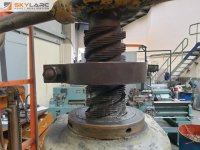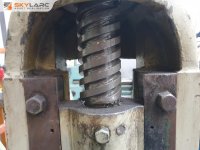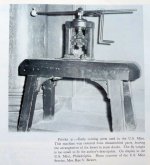From The Cabinet Cyclopaedia by Dionysius Lardner, 1833.
Methods of making large female-threaded nuts and sleeves in the olden days:-
‘The most ancient is probably that adopted by whitesmiths in general in the making of vices. The course is this:-
The screw A (fig 49) being finished, and a band of iron, forged to the proper size, and made very soft, is carefully wrapped round in the hollow of the screw, so as to form an exact counterpart to the worm; this coil, B, in being taken from the mandrel screw, is filed bright on the outside, and inserted within the welded iron tube C, which is likewise cleaned inside. The worm being found on trial by the screw, to be properly adjusted, the whole of the worm and interior of the box are plentifully covered with a mixture of pounded borax and water, and upon this is thrown a sufficient quantity of bits of brass wire to unite by their fusion the worm and box. The whole is then enveloped in a thick mass of fire-clay, and submitted to the fire; the workmen urging the heat with the bellows until the lump appears red-hot: the melting of the brass, and consequent soldering of the work, is indicated by a dense blue flame, which arises from the hearth, and which, after having continued for a few minutes, serves to assure the workman that the fusion is complete. The article is then withdrawn from the fire, and rolled until it is cool, upon the ground, in order that the molten brass may not fall in gluts on one side, and so impeded the progress of the screw. The clay is then knocked off, the screw worked into the box with oil, and the whole finished by filing or turning on the outside.'
‘ The next method, which is generally that resorted to for the production of boxes for fly-screws and others having several worms, consists in casting the work in brass upon the mandrel, which in this case becomes a model. To do this, it is merely necessary to place upon the iron screw a wooden or clay model of the size of the intended screw-box, and then mould the whole in a case of proper sand. The screw is then taken out, and the model removed; after which the screw, having been covered with a mixture of whiting and water, of the consistence of paint, to prevent the brass from adhering to the iron, is returned to the moulding case, and the brass poured in, so as to surround the screw at the place and to the extent occupied by the model. On becoming quite cool, the work is placed upon the anvil, and the brass lump hammered all round until sufficiently loosened by expansion to allow the screw to be withdrawn, which it will do readily when the latter is quite smooth and cut very true: any trifling irregularities are corrected by working the screw a few times through the box.’
The author noted that these methods could not be applied to very large nuts and bushes. Those, and female threads in general, were now produced by machining.









